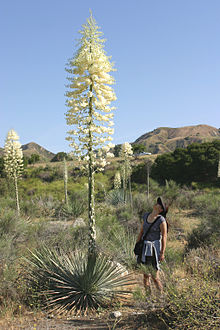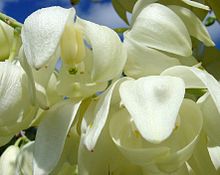- Hesperoyucca whipplei
-
Chaparral yucca 
Scientific classification 
Kingdom: Plantae clade: Angiosperms clade: Monocots Order: Asparagales Family: Asparagaceae Subfamily: Agavoideae Genus: Hesperoyucca Species: H. whipplei Binomial name Hesperoyucca whipplei
(Torr.) Trel.Hesperoyucca whipplei (syn. Yucca whipplei ) (chaparral yucca, our Lord's candle, Spanish bayonet, Quixote yucca, common yucca, foothill yucca) is a species of flowering plant closely related to, and formerly usually included in, the genus Yucca. It is native to southern California, United States and Baja California, Mexico, where it occurs mainly in chaparral, coastal sage scrub, and oak woodland plant communities at altitudes of 300–2500 m.
Contents
Description
It produces a stemless cluster of long, rigid leaves which end in a sharp point. The leaves are 20–90 cm (rarely to 125 cm) long and 0.7–2 cm wide, and gray-green in color. The leaf edges are finely saw-toothed.
The single inflorescence grows extremely fast, and reaches 0.9–3 m tall, bearing hundreds of elliptical (bell shaped) white to purplish flowers 3 cm diameter on a densely branched panicle up to 70 cm broad, covering the upper half of the inflorescence. The fruit is a dry winged capsule, which splits open at maturity to release the seeds.
The plant takes several (usually 5+) years to reach maturity and flower, at which point it usually dies. Most subspecies produce offshoots from the base, so that although the parent plant flowers and dies, a cluster of clones around its base continue to grow and reproduce.
Taxonomy
The taxonomy of Hesperoyucca whipplei is complex and controversial.[1] Hesperoyucca was described as a genus by Georg Engelmann as long ago as 1892,[2] but it has taken recent DNA analysis to confirm that they are genetically distinct from Yucca.[3] The splitting of Hesperoyucca from Yucca is still not widely reflected in available literature or online (for example, the British Royal Botanic Gardens, Kew and the Royal Horticultural Society websites do not recognise the name as current).[4][5]
Among those botanists who have treated (or still treat) it as a species of Yucca, six subspecies have been recognised (Hochstätter 2000,[6] 2002,[7] 2004[8]); others have regarded them as varieties.[9] Yet others (e.g. Flora of North America and the Jepson Flora) do not recognise any subspecies or varieties (within either Yucca whipplei or Hesperoyucca whipplei ), as the wide variability within the species precludes the segregation of discrete subspecies.
Hochstätter's subspecies are:
- Yucca whipplei ssp. whipplei
- Yucca whipplei ssp. caespitosa
- Yucca whipplei ssp. intermedia
- Yucca whipplei ssp. percursa
- Yucca whipplei ssp. newberryi
- Yucca whipplei ssp. eremica
The plant treated as the subspecies Yucca whipplei subsp. newberryi has been shown to be genetically distinct, and is often treated as a distinct species, Hesperoyucca newberryi. It is native further east, in Arizona, and differs in the capsules being unwinged or with only slight wings.
Ecology
It is pollinated by the California yucca moth (Tegeticula maculata), a relationship which has become a classic example of symbiosis. Working at night, the female yucca moth collects up to a dozen sacks of pollen grains called pollinia and forms them into a massive ball. She then flies to another plant and lands on the ovary of a flower. Standing with her head near the stigma, she inserts her ovipositor into the ovary wall and lays a single egg. She then rubs her pollen mass against the central stigmatic depression, ensuring pollination. The pollinated ovary will now produce many seeds, ensuring an ample food supply for the larva. Although many associations of Yucca and yucca moth exist, Tegeticula muculata and Hesperoyucca whipplei form an exclusive relationship.[10]
Etymology
- "Yuca" is a native name for the unrelated Manihot.
- Yucca whipplei is named after A. W. Whipple (1816–1863), a surveyor who oversaw the Pacific Railroad Survey to Los Angeles in 1853. [11]
- The name our Lord's candle is derived from its huge, flame-shaped inflorescence.
- Spanish bayonet refers to the needle-sharp leaf tips which can cause discomfort to the unwary passer-by.
Cultivation and uses
Yucca whipplei is used in xeriscaping in Southern California, but reportedly is difficult to grow outside of its native range (although it is widely available from specialist nurseries in the UK).[12] It is extremely drought tolerant and thrives in clay soils.
It was used extensively by Native Americans [13]
- Fiber from the leaves was used for sandals, cloth, and rope.
- Young flowers are edible but may be bitter.
- Fruits can be eaten raw, roasted, or pounded into meal.
- Seeds were roasted and eaten whole or ground into flour.
- Roots pounded in water produce a lather that was used as soap and shampoo.
Gallery
References and external links
- ^ Flora of North America
- ^ IPNI
- ^ Agavaceae.com – page includes a key toYucca and the three recognised species of Hesperoyucca
- ^ RBG Kew search results for Hesperaloe
- ^ RHS online Plant Finder
- ^ Hochstätter, Fritz (Hrsg.): Yucca (Agavaceae). Band 1 Dehiscent-fruited species in the Southwest and Midwest of the USA, Canada and Baja California, self-published, 2000. ISBN 3-00-005946-6
- ^ Hochstätter, Fritz (Hrsg.): Yucca (Agavaceae). Band 2 Indehiscent-fruited species in the Southwest, Midwest and East of the USA, self-published. 2002. ISBN 3-00-009008-8
- ^ Hochstätter, Fritz (Hrsg.): Yucca (Agavaceae). Band 3 Mexico , self-published, 2004. ISBN 3-00-013124-8
- ^ USDA NRCS PLANTS database
- ^ Reports on ongoing research by Professor Dan Udovic at University of Oregon
- ^ Dale, N. (1986), p24. Flowering Plants of the Santa Monica Mountains. Capra Press.
- ^ RHS Plant Finder 2009–2010. Dorling Kindersley. 2009. p. 804. ISBN 978-1-4053-4176-9.
- ^ Dole, J. W. and Rose, B. B. (1996), p59, Shrubs and Trees of the Southern California Coastal Regions and Mountains. Foot-loose press.
Categories:- Agavoideae
- Flora of California chaparral and woodlands
- Flora of Baja California
Wikimedia Foundation. 2010.






